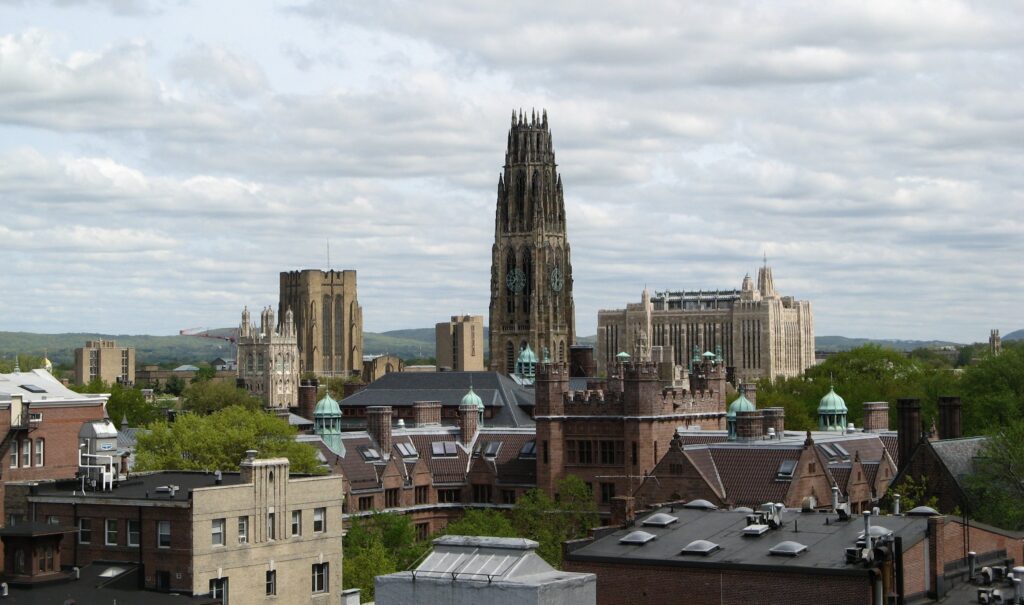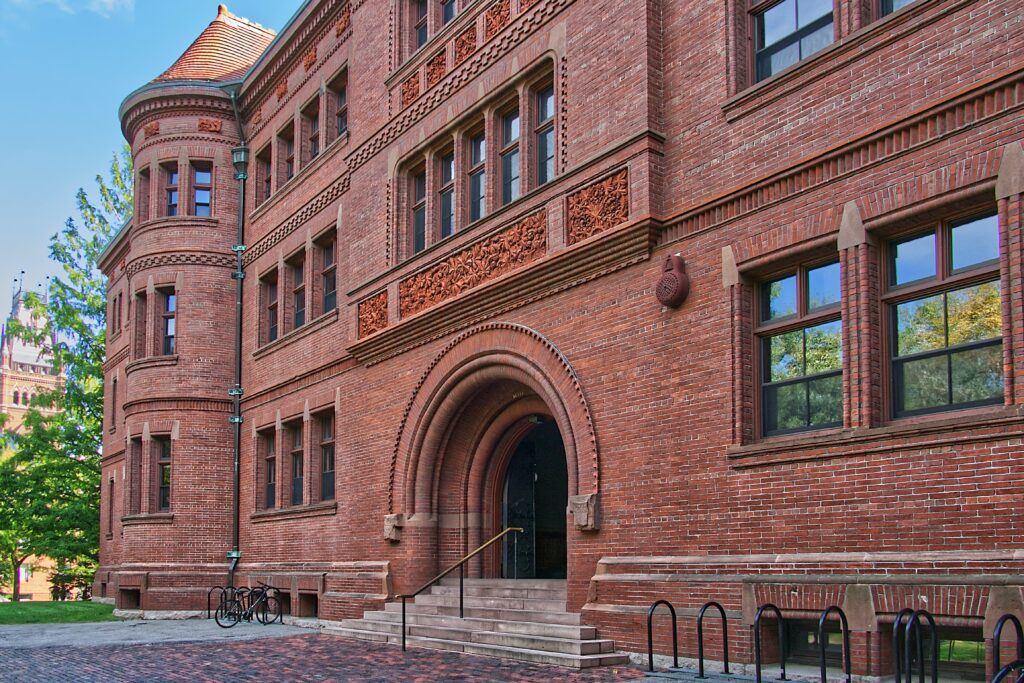
Yale vs. Harvard: Comparing Top Schools
When comparing the best Ivy League schools, the Yale vs. Harvard debate is often front and center. As the two oldest Ivies, Yale and Harvard both share a long history of academic excellence and global recognition — not to mention one of the longest standing rivalries in collegiate football. However, each school is also distinct, with its own identity, academic strengths, and campus culture.
In this article, we will focus on comparing two of the best Ivy League schools: Yale and Harvard. In our Yale vs. Harvard exploration, we will look at several aspects of the schools, from their physical campuses to their programs and special offerings.
Here is some of what we will cover in our discussion of Harvard vs. Yale:
- What makes the best Ivy League schools international powerhouses
- Answers to fundamental questions like “What is Yale known for?” and “What is Harvard known for?”
- Unique traditions at Yale vs. Harvard
- The latest Yale vs. Harvard Ivy League rankings
- An overview of each school’s major offerings
- The cost of an Ivy League education, including a look at Harvard vs. Yale financial aid
- How to decide which of the best Ivy League schools to apply to
- The benefits of attending Yale vs. Harvard, and more!
As we dive into our Yale vs. Harvard debate, we’ll also touch on what a liberal arts education is and what it looks like at these top universities. But first, let’s review what the Ivy League is and how Yale and Harvard fit into this group of elite institutions.
Best Ivy League Schools
The Ivy League schools are some of the most famous universities in the world. But, how much do you actually know about the Ivy League?
Today, Ivies are known as elite, academically rigorous institutions. But the Ivy League was originally founded as an athletic conference. In other words, these schools were grouped together to compete in sports. Over time, they developed robust academic programs that helped them stand out on a global scale. As their graduates went on to receive awards, accolades, and prominent positions in government, business, and science, the Ivies became household names.
Today, the Ivy league includes eight schools:
- Harvard University
- Yale University
- Princeton University
- Dartmouth College
- Columbia University
- Cornell University
- Brown University
- The University of Pennsylvania
While all these schools offer a top-rate education, the Harvard and Yale University rankings tend to stand out from the pack. Their consistently high rankings are thanks to their academic excellence, alumni outcomes, and global prestige. As we continue, we will compare these two titans of higher education to better understand what makes Yale and Harvard unique.
To begin our comparison of Yale vs. Harvard, let’s take a look at where each school is located and how that impacts the student experience.
Where is Yale?

Yale is located in the city of New Haven, Connecticut. New Haven is a small coastal city located just a couple hours from two major East Coast cities — New York City and Boston. The Yale website brags that New Haven is “large enough to be interesting, but small enough to be friendly.”
Despite its small size, New Haven also has international acclaim. It is known for its foodie culture, in which residents enjoy some of the best pizza, sushi, and hamburgers in the world and cuisines from over 120 countries. Those who love theater can enjoy acclaimed performances at the Schubert Theater, and outdoor enthusiasts can enjoy beautiful hikes in East Rock Park.
Exploring Yale’s campus
Undoubtedly, Yale’s campus is the heart of New Haven. Yale is the largest employer in the city of New Haven, and many local attractions are located on Yale’s campus. Visitors to New Haven often go to visit historic Yale sites like the Old Campus, which houses Yale’s freshmen housing and many academic buildings. The Sterling Library also draws many visitors, as its architecture mirrors a gothic cathedral. Sports lovers often come to campus for the Yale Bowl, the site of many college football games.
Yale’s location in New Haven is a key part of the student experience. Attending Yale gives students a unique urban-suburban experience, as Yale’s campus is a tranquil oasis amidst a bustling city. While some have stated that the area surrounding Yale’s campus is unsafe, Yale has implemented many safety measures to ensure student well-being.
As a central part of an urban environment, Yale has had a complex history with New Haven. Locals both value and critique the college’s presence in the city, which faces many social problems. Yale has attempted to ensure a positive relationship with New Haven by investing in the city, in part through outreach programs and partnerships led by the Office of New Haven Affairs.
Up next, let’s continue our Harvard vs. Yale discussion by looking at Harvard’s home in Cambridge.
Where is Harvard?

One important aspect of the Harvard experience is the school’s location in Cambridge, Massachusetts. Though a small city in and of itself, Cambridge is located just across the Charles River from Boston, which adds to the list of exciting attractions and resources available to Harvard students. As one of the first cities in the Thirteen Colonies of the United States, Cambridge is the site of many historic moments in the American Revolution.
Cambridge and Boston are known for being America’s college towns — 50 schools call these cities home, including MIT. As such, attractions include a seemingly endless supply of coffee shops and bookstores. Cambridge also has a lively arts scene, many museums, and stunning architecture. Both Cambridge and Boston are known for being hubs of technological innovation, housing startups for many entrepreneurs and tech-savvy people. Luckily, getting between Cambridge and Boston is also easy thanks to the Boston subway system, the T.
Getting to know Harvard’s campus
On campus, Harvard students mingle amongst famous international tourist destinations like the Widener Library, Harvard Art Museum, and the iconic Harvard Yard. The Widener Library hosts 57 miles of shelves of books in 450 languages, including a Gutenberg bible, the first complete book in the West. Just across from campus, the Harvard Art Museums are free to visit and open to all. A combination of three museums in one roof, the Harvard Art Museums boasts everything from sculptures to modern art to photography.
Directly outside Harvard’s campus is Harvard Square, a bustling center with shops and restaurants for tourists and students alike. Meanwhile, many students take advantage of the broader Boston area’s academic, technological, and cultural resources. From catching a game in Fenway Park to walking the historic Freedom Trail, Boston has no shortage of exciting and enriching experiences to offer.
Now that we have a sense of where these two schools are, let’s dive into a comparison of a Yale vs. Harvard education.
Harvard vs. Yale Academic Opportunities
When comparing the benefits of Yale vs. Harvard, perhaps the most important consideration is each school’s academic opportunities. Undoubtedly, the response to both “What is Yale known for?” and “What is Harvard known for?” is the strength of their academic programs and breadth of student resources. But, how are these two institutions similar or different in what they offer? In the chart below, we will compare Yale vs. Harvard across curriculum, majors, research opportunities, study abroad programs, and more.

Comparing a Harvard vs. Yale Education
| Aspects of a College Education | Harvard vs. Yale |
|---|---|
| Curriculum | Yale and Harvard both take a “liberal arts” approach to undergraduate education. As such, both schools have their own type of core curriculum — Harvard has a General Education requirement, while Yale has distribution requirements. This means that no matter your major, you will take courses across different disciplines that build core skills in writing, quantitative reasoning, and language. |
| Majors | There are 80 Yale majors and 50 Harvard concentrations (which is how the school refers to its majors). While Yale offers more major options, Harvard majors include some unique and interdisciplinary offerings like Social Studies. |
| Interdisciplinary Studies | While Yale does allow double majors, Harvard has more options for combining disciplines. At Harvard, students can choose double, joint, and special concentrations, which allow them to combine fields of study or even create their own. Without a doubt, in the Yale vs. Harvard competition, Harvard offers more in the way of interdisciplinary studies. |
| Dual Degrees | Harvard offers a unique opportunity for students to gain a master’s degree alongside their bachelor’s, referred to as a concurrent master’s. This option is only available for specific Harvard majors, including applied math, German, and computer science. Similarly, some Yale majors are eligible for a joint graduate degree, such as music, forestry and environmental science, and public health. |
| Research | Yale invests heavily in undergraduate research, with over 100 summer fellowships set aside for freshmen each year. 95% of undergraduate science majors at Yale engage in research with faculty. At Harvard, the Office of Undergraduate Research and Fellowships supports students doing research through courses, independent studies, or assistantships. |
| Study Abroad | Both Harvard and Yale offer numerous study abroad opportunities and funding opportunities for a year, semester, or summer abroad. Students can earn academic credit or complete research in many of these programs. A greater percentage of Yale students — 71% at Yale vs. Harvard’s 50% — study abroad. Yale also has several unique abroad programs such as Yale in London or the Light Fellowship for studying Chinese, Japanese, or Korean. |
| Special Programs | Yale and Harvard both have special programs designed to enhance student academic experiences. Harvard allows students to build their own special concentrations under the guidance of an advisor. Meanwhile, Yale offers directed studies for freshmen who wish to dive into texts from an array of disciplines. Yale also has freshmen seminar courses that allow freshmen to build community while studying a unique topic and faculty-led ensembles that allow musically inclined students to learn and perform alongside faculty. |
In our academic exploration of Yale vs. Harvard, we briefly touched on how both Harvard and Yale are liberal arts colleges. So, let’s clarify what a liberal arts college is in more detail.
What is a Liberal Arts College?

When asking “what is Yale known for?” and “what is Harvard known for?”, a fundamental answer is that they’re both prestigious liberal arts colleges. By definition, a liberal arts college is one that emphasizes a broad, well-rounded education focused on developing critical thinking, communication, and writing skills. Liberal arts colleges do so by encouraging, and sometimes requiring, courses in a range of fields, from the general sciences to social sciences and the humanities. Additionally, liberal arts colleges are known for prioritizing the undergraduate experience, offering smaller classes and close faculty-student interactions.
But wait, Yale and Harvard are also large, research universities — so how can they be considered liberal arts colleges, too? Well, while both Yale and Harvard are high-powered research institutions, they’re also home to smaller undergraduate colleges. When applying to Yale or Harvard for your undergrad, you’re actually applying to Yale College or Harvard College, both of which offer a liberal arts education. You can learn more about what it takes to get into Yale vs. Harvard in these CollegeAdvisor webinars: “How to Get into Harvard” and “How to Get into Yale.”
Now that we’ve established what “liberal arts” means in the context of Yale vs. Harvard, let’s explore some distinct characteristics of each college.
What is Harvard known for?
A common question for those investigating Ivy League rankings is, “What is Harvard known for?” When exploring the best Ivy League schools, it’s important to understand the nuances between them. That way, you can make the best decision for you when it comes to fit and culture.
What is Harvard known for academically? Harvard’s undergraduate college is known for its programs in economics, government, history, and the life sciences. The university also boasts globally recognized graduate programs in law, business, and medicine. Regardless of which Harvard program you enroll in, the academic atmosphere will be fast-paced, competitive, and focused on career success.
For many, part of Harvard’s allure lies in its name recognition and the academic, social, and career opportunities it unlocks. Harvard is known for its global brand, extensive alumni model, and self-directed academic model. These factors attract some of the most driven, hardworking, and talented minds across the U.S. and the world.
While a Harvard education won’t come without a cost, Harvard financial aid is well known for providing its students with comprehensive aid packages. Later on, we’ll take an in-depth look at Harvard’s costs and compare the strength of each school’s financial aid offerings.
What is Yale known for?
When comparing Yale vs. Harvard, many characteristics overlap. For example, Yale is just as highly ranked as Harvard nationally, with Yale University rankings even outperforming Harvard’s in some cases. So what is Yale known for specifically?
Yale’s reputation for excellence centers on the humanities, with standout Yale majors spanning English, philosophy, and the arts. Yale University rankings also shine at the graduate level — experts frequently rank Yale’s Law School and School of Drama are ranked #1 and #2 in the nation, respectively. As such, getting into these programs is incredibly challenging.
Focusing in on the undergraduate experience, Yale’s undergraduate culture is known for being close-knit, discussion-driven, and centered on intellectual exploration. Students bond immensely through the residential college system, where they live and learn with students from diverse backgrounds and across Yale majors. Each of the 14 residential colleges creates a microcosm of the broader college, with faculty supporting students as they navigate college life. Special events like College Teas and arts performances further add to the social and intellectual benefits of the colleges.
Unfortunately, just like Harvard, many recognize Yale tuition for being very expensive. Though Yale tuition is very high, Yale financial aid will work with students to figure out how to afford the cost of attendance.
Latest Harvard vs. Yale Rankings

Another important discussion in the comparison of Yale vs. Harvard are the schools’ rankings. When exploring rankings, it is important to remember that experts calculate college rankings in many different ways depending on the source. Most ranking systems focus on student outcomes, such as retention and salary upon graduation, and student satisfaction. Other factors that go into college rankings include resources, alumni giving rates, and student debt, among others.
Ivy league rankings for all eight Ivies tend to be very high, but Yale vs. Harvard is often one of the tightest races. Here are some of the current Yale vs. Harvard rankings:
| Source | Harvard University Ranking | Yale University Ranking |
| Forbes America’s Top Colleges | #8 | #4 |
| Niche Best Colleges in America | #4 | #2 |
| Times Higher Education World University Rankings | #3 | #10 |
| U.S. News National Universities | #3 | #5 |
As you can see, there isn’t a clear winner in the comparison of Yale University rankings vs. Harvard University rankings. Each school has plenty to offer, so understanding the nuances between a Yale vs. Harvard education is key to making an informed decision.
For more Harvard and Yale University rankings, check out each school’s U.S. News page — you can find everything from rankings for majors like psychology and artificial intelligence to categories like learning communities and undergraduate research. Up next, let’s explore Harvard vs. Yale majors in greater depth.
Majors at Yale vs. Harvard
When comparing Yale vs. Harvard, one key difference is the range of academic options. At Yale, students can choose from 80 undergraduate majors. On the other hand, Harvard offers only 50 concentrations (concentrations = majors). Here are some instances where Yale and Harvard majors overlap:
- Anthropology
- Applied Mathematics
- Chemistry
- Classics
- Economics
- English
- History
- Linguistics
- Music
- Neuroscience
- Philosophy
- Psychology
- Sociology
While these majors may be identical in name, it’s important to explore the specifics of each school’s program to see if the curriculum and learning objectives align with your future career goals.
Now let’s look at some Harvard and Yale majors that don’t have perfect equivalents. For instance, here is a table of Harvard vs. Yale art-related majors:
| Harvard Majors | Yale Majors |
| Theater, Dance & MediaHistory of Art and ArchitectureArt, Film, and Visual Studies | Theater and Performance StudiesArtComputing and the ArtsHistory of ArtFilm and Media Studies |
As you can see, these art majors explore very different areas and will make for a very different educational experience.
Interdisciplinary majors
Both schools allow students to create custom majors or combine disciplines. At Harvard, students may pursue joint concentrations or design a special concentration with faculty guidance and committee approval. This allows for personalized combinations, like technology and education or music and liberal arts. Meanwhile, many Yale majors allow students to pursue interdisciplinary studies or special divisional majors, such as Urban Environmental Studies. This flexibility is a key reason the Yale University ranking remains consistently high among national and global lists for undergraduate education.
Both Harvard and Yale are excellent choices for students with both broad and niche academic interests. Their strong showings in Ivy League rankings reflect the immense academic opportunities they offer — but at what cost?
The Cost of an Ivy League Education

The total cost of attendance at Ivy League schools, including tuition, housing, fees, and personal expenses, is around $90,000 per year. This figure reflects the “sticker price,” or the amount a student would pay without any financial assistance. Fortunately, most students do not pay the full sticker price to attend Ivy League schools. Many Ivy League schools offer substantial need-based financial aid and commit to meeting 100% of demonstrated financial need.
With financial aid, attending an Ivy League school can be an affordable and high-return investment for many families. The high Harvard and Yale University rankings are strong indicators of long-term value and prestige. Despite their high cost, experts frequently rank them among the Best Value Colleges and high among Ivy League rankings. That’s in large part due to generous financial aid packages, high graduation rates, strong academic reputations, and excellent career outcomes and alumni networks.
Many families ask, “what is Harvard known for beyond academics?” when deciding if the cost is worth it. The answer lies in Harvard’s prestige, alumni connections, and long-term earnings. Financial aid, academic rigor, and career preparation help Harvard and Yale solidify their place among the best Ivy League schools. For many families comparing Yale vs. Harvard, understanding these aid policies is a crucial part of the decision-making process.
Havard vs. Yale Tuition
Now, let’s compare Harvard vs. Yale tuition rates. Harvard tuition for the 2025–2026 academic year is $59,320 while Yale tuition for 2025–2026 is $69,900. This is only tuition, and not the full “sticker price.”
Both universities have experienced consistent tuition growth over the last decade at around 3–4% per year. When comparing Yale vs. Harvard, it is important to note that Harvard raised the Harvard tuition nearly $15,000 in the last decade. In comparison, Yale increased the Yale tuition by over $20,000.
In addition to tuition, other expenses comprise your total cost of attendance including housing, food, student fees, and books. You should consider these extra costs when making decisions between Yale vs. Harvard. For instance, students pursuing more intensive Harvard or Yale majors in science or the arts may also have program-specific expenses. Consider additional requirements such as lab materials or performance supplies for your program of choice.
Yale vs. Harvard Financial Aid
Both Harvard and Yale offer some of the most generous financial aid programs in the country. Their need-blind admissions policies include a commitment to meeting 100% of demonstrated financial need. Neither institution offers merit-based aid, meaning all aid is based solely on a family’s financial circumstances.
Harvard financial aid
What is Harvard known for in terms of their financial aid offerings? Harvard financial aid offers need-blind admissions for all applicants and meets 100% of demonstrated financial need. Another reason students explore “why Harvard?” and “what is Harvard known for?” is its dedication to an affordable, prestigious education through extensive aid. They boast the three-tiered model for affordability:
- Completely free for families earning below $85,000
- Free tuition for families earning $85,000–$150,000, meaning they typically pay 0–10% of their annual income
- Tailored aid that is calculated based on individual circumstances for families earning above $150,000
This structure means that students of varying financial means can have a chance to afford a Harvard education.
Yale financial aid
Now you may be wondering, “what is Yale known for in terms of financial aid?” One reason families search “what is Yale known for?” is its ability to pair academic excellence with affordability. Yale financial aid offers need-blind admissions and adopts similar policies to Harvard. For families with income under $75,000, there is no expected contribution. Families earning $75,000–$200,000 pay on a sliding scale based on income and assets.
When comparing Yale vs. Harvard, it is important to note 55% of students receive financial aid at both schools. At Harvard, 1 in 4 students pays nothing to attend; meanwhile, the average financial aid package is $66,708. These generous financial aid policies are a major reason why both Harvard and Yale consistently rank among the best value colleges in the country. For more information on affording a Harvard vs. Yale education, check out our guides on how to pay for Harvard and how to pay for Yale.
Which campus is better?

When deciding between Yale vs. Harvard, you may be wondering how the campuses compare. Let’s look at some of the key differences between the Yale vs. Harvard campuses.
First up is Harvard, located in Cambridge, Massachusetts. Cambridge is located just across the Charles River from Boston. The campus architecture is a blend of colonial, Georgian, and modern buildings. Although its urban setting limits the amount of possible green space, Harvard Yard is an iconic part of the university’s campus culture. At Harvard, students have access to top-tier science and research buildings and everything the nearby city of Boston has to offer.
Yale University is in New Haven, Connecticut, which is less urban than Harvard’s surrounding area. What is Yale known for on campus if not architecture? It’s certainly one reason many regard Yale as one of the best Ivy League schools. Yale’s famous campus architecture is a gothic revival style with castle-like buildings, courtyards, and green spaces. The campus scene contributes to the high Yale University ranking year after year — students at Yale have access to recently updated science buildings, like the Wu Tsai Institute, and hubs for student activity, like the Schwarzman Center.
Resources, residential life, and transportation
Both universities offer vast student resources including health services, counseling, academic support centers, career offices, and global fellowship support. Students at both Harvard and Yale also get to enjoy renowned college libraries and a variety of dining halls. In terms of campus safety, both campuses have full-time campus police and blue-light systems.
Now let’s look at residential life at each college. Up first is Harvard’s House System. Harvard places students into one of 12 upperclassmen Houses after freshman year in Harvard Yard. With this comes a strong house pride and traditions. This is a bit different compared to Yale’s Residential Colleges. In this system, Yale sorts students into one of 14 Residential Colleges as first-years, where they stay all four years of undergrad.
Finally, let’s consider accessibility and location. Harvard has excellent public transportation access via the T (Boston subway) and is just 10–15 minutes from downtown Boston. Yale is served by the Metro-North train, connecting to New York City in about 2 hours.
If you’re deciding between Harvard vs. Yale, visiting both campuses is one of the best ways to get a feel for their community differences.
Harvard vs. Yale Football
The Yale vs. Harvard football rivalry, known simply as “The Game,” is one of the oldest in American college football. First played in 1875, it has become an iconic annual matchup. The hosting alternates yearly — Yale hosts in odd-numbered years while Harvard hosts in even-numbered years. Harvard vs. Yale football is a spirited event where history, pride, and community collide, making it a highlight of the Ivy League experience.
Harvard Stadium was built in 1903 and seats approximately 30,000 people. Many prospective athletes also ask what is Harvard known for in athletics? The answer lies in Harvard’s success in crew, squash, and track. Harvard is home to 42 varsity teams. Recreational and club sports are also very popular, with well-maintained facilities across campus.
The Yale Bowl, built in 1914, has a capacity of approximately 61,000. Yale is home to 35 varsity teams, plus many club sports and intramurals. You may be wondering, “what is Yale known for in athletics?” It’s been part of American sports for decades. In fact, Walter Camp, better known as “the father of American football,” was a Yale alum.
How to Compare Top Universities
Whether it’s Yale vs. Harvard or another elite institution, a top-tier degree can open doors to career opportunities, advanced study, and global networks. However, prestige alone shouldn’t be the deciding factor. The best university is the one that is the best fit for you.
When deciding between Yale vs. Harvard or other top colleges, look beyond rankings at other factors. Ask how well each school aligns with your goals, values, and learning style. Here are some key factors to consider when comparing schools.
Factors to Consider When Comparing Schools

Academics
Does the school offer strong programs in your intended major? Students who want academic flexibility often find Yale majors especially appealing thanks to plenty of cross-disciplinary options.
Location
Is the school close to your desired industry or internships? Take the time to consider the commute, what it takes to travel home, and other important lifestyle preferences.
Campus life and student experience
What’s the campus culture like? Are there clubs, events, and social traditions that interest you? For the best chance at finding the perfect fit, do plenty of research and be sure to visit before making your final decision.
Cost and financial aid
You should have the answers to these questions before enrolling: What’s the real cost of attendance after financial aid?
Career opportunities and alumni networks
How robust are career services for students? Are services like internship and mentorship matchmaking available? What are five- and ten-year outcomes for graduates in the career track you choose? These long-term outcomes are key reasons why the Harvard vs. Yale University rankings are consistently among the best.
To get a good sense of each university, engage in campus visits and virtual tours, talk to students and alumni, attend college fairs and webinars, and don’t forget to consider the cost.
Yale vs. Harvard: 5 Benefits of Attending Each
To summarize, here are five benefits of attending Harvard:
5 Benefits of Attending Harvard

1. Proximity to industry and innovation hubs
Harvard’s location in Cambridge near Boston places students near leading tech firms, hospitals, and think tanks.
2. Strength in STEM and quantitative fields
Harvard has world-class programs in engineering, economics, computer science, and biomedical research, with access to cutting-edge labs and innovation centers.
3. Massive global brand power and alumni reach
Harvard’s name carries unparalleled weight worldwide, backed by an immense alumni network.
4. Generous need-based financial aid
Harvard’s financial aid is very generous. Families earning under $85,000 typically pay nothing, and those earning up to $150,000 often pay only 0–10% of income.
5. Diverse and talented student body
Harvard attracts high-achieving students from around the world, creating a vibrant, intellectually stimulating community.
On the other hand, here are five benefits of attending Yale:
5 Benefits of Attending Yale

1. Strengths in humanities, arts, and writing
Yale has an exceptional reputation in the arts, attracting creative and thoughtful students from around the world.
2. Unique first-year programs like Directed Studies.
Programs such as Directed Studies offer a rigorous, honors-level introduction to small seminar settings.
3. More immersive and community-driven Residential College System
Yale’s 14 Residential Colleges are vibrant social and academic communities that create lasting connections from your first year through graduation.
4. Collaborative academic environment with smaller class sizes
Yale fosters a more intimate, discussion-based learning style, particularly in the humanities and social sciences, with strong faculty-student relationships.
5. Beautiful, historic campus with strong traditions
Asking, “what is Yale known for?” will yield a school rooted in tradition, social responsibility, and close-knit academic community. Yale’s Gothic architecture, grand courtyards, and iconic libraries create a unique and inspiring academic atmosphere, and traditions like the Yale vs. Harvard game contribute to a rich, memorable student experience.
As you can see, there are benefits to choosing whichever school wins your personal Yale vs. Harvard comparison. And, given that these are two of the best Ivy League schools, you really can’t make a wrong decision!
Yale vs. Harvard – Final Takeaways
Yale and Harvard are two of the most prestigious institutions worldwide and among the highest in the Ivy League rankings. While both are in the northeastern U.S., they offer distinct experiences in terms of academics, campus culture, and student life.
Here are some key takeaways about Yale vs. Harvard:
Yale vs. Harvard Key Takeaways

Academics
Both universities offer top-tier academic opportunities, ranking as some of the best Ivy League schools every year.
Liberal arts focus
Each institution combines the resources of a large research university with the personalized learning environment of a smaller undergraduate college. Both universities offer curriculum deeply rooted in the liberal arts.
Rankings and reputation
Harvard typically ranks slightly higher in global rankings, particularly for its graduate programs. Many recognize Yale, on the other hand, for its undergraduate teaching excellence and close-knit college system.
Majors
Both schools offer a wide variety of majors in areas like STEM, business, history, political science, and the arts.
Cost and financial aid
Tuition and total costs at both schools are high, but both schools offer generous need-based financial aid.
Campus and culture
Yale’s Gothic architecture and residential college system foster a strong sense of community. Harvard’s urban location provides easy access to Boston’s resources and energy.
Common benefits
Both universities offer exceptional academic rigor, influential alumni networks, strong career opportunities, generous financial aid, and unparalleled name recognition. They differ mostly in teaching style, culture, and student experience.
Students often consider Harvard vs. Yale when looking for a school that balances prestige, opportunity, and the right academic and social environment. As such, choosing between Yale vs. Harvard, or other top universities like MIT, comes down to personal fit, intended major, and long-term goals.
If you’re unsure where to start, CollegeAdvisor can help you navigate every step of applying to top schools — and help you make a decision about Yale vs. Harvard that’s right for you.

Courtney Ng and Bailey Bennett co-wrote this article. Looking for more admissions support? Click here to schedule a free meeting with one of our Admissions Specialists. During your meeting, our team will discuss your profile and help you find targeted ways to increase your admissions odds at top schools. We’ll also answer any questions and discuss how CollegeAdvisor.com can support you in the college application process.
